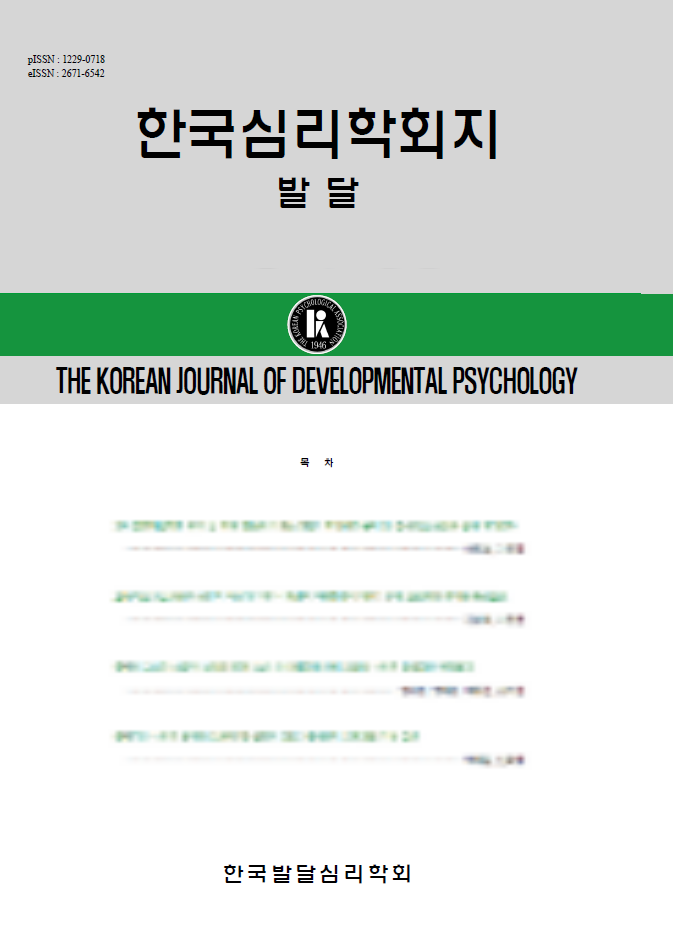open access
메뉴
open access
메뉴 ISSN : 1229-0718
ISSN : 1229-0718

본 연구는 Woodward와 Guajardo(2002)의 연구 패러다임를 기반으로 한국 영아들의 가리키기 행동 목표 이해 발달을 살펴보고자 하였다. 실험 1에서 9개월 영아들은 접촉 또는 통제 조건에 참가했다. 접촉 조건의 영아들은 친숙화 단계에서 행위자가 두 물체 중 하나를 검지로 접촉하면서 가리키는 장면을 보았다. 검사 단계에서는 두 물체의 위치가 바뀌었고, 친숙화 단계에서와 동일한 물체를 가리킨 기존 목표 사건과 가리키는 물체가 달라진 새 목표 사건을 보았다. 통제 조건은 친숙화 단계에서 한 개의 물체만 있었다는 점을 제외하면 접촉 조건과 동일했다. 실험 결과, 접촉 조건의 영아들은 새 목표 사건을 더 오래 보았고, 통제 조건의 영아들은 사건별 평균 응시 시간에 차이가 없었다. 물체와 행위자의 검지 사이에 3.5cm의 거리를 둔 실험 2(비접촉 조건)에서도 9개월 영아들은 새 목표 사건을 더 오래 보았다. 실험 3에서는 7개월 영아들을 대상으로 실험 1의 접촉 조건과 동일한 실험을 실시했는데 사건별 평균 응시 시간에 차이가 없었다. 본 연구의 결과는 한국 영아들의 타인의 가리키기 행동의 목표 이해가 7개월에서 9개월 사이에 발달함을 보여주고 있다.
The present research examined how Korean infants interpret others' pointing actions. In Experiment 1, the infants in the touch condition were familiarized with an event in which the actor pointed to one of the two objects. After the positions of objects were switched, each infant received test events of two types: The actor pointed to the new goal object(new-goal event) or the old goal object(old-goal event). In the control condition, there was only one object during familiarization. As a result, the infants in the touch condition looked reliably longer at the new-goal event than the old-goal event. In contrast, the infants in the control condition looked about equally at both events. In Experiment 2, 9-month-olds looked reliably longer at the new-goal event even though there was a 3.5cm gap between the actor's index finger and the target object. In Experiment 3, 7-month-olds were tested in the same procedure as that of the touch condition in Experiment 1. They looked about equally at both events. The results showed that between 7 and 9-month-old Korean infants develop their ability to understand others' pointing actions as goal-directed.
Baillargeon,R., (1994) How do infants learn about the physical world, Current Directions in Psychological Science
Balaban, M. T., (1997) Do words facilitate object categorization in 9-month-old infants, Journal of Experimental Child Psychology
Baron-Cohen,S., (1991) Precursors to a theory of mind: understanding attention in others in : Natural theories of mind: Evolution, development and simulation of everyday mindreading , Blackwell
Bates, E., (1979) The emergence of symbols: Cognition and communication in infancy, Academic Press
Bates, E., (1987) Language and communication in infancy in : Handbook of infant development , Wiley
Biro, S., (2007) Infants’ perception of goal-directed actions: development through cue-based bootstrapping, Developmental Science
Blake, J., (1994) Form and function in the development of pointing and reaching gestures, Infant Behavior and Development
Carpenter, M., (1998) Social cognition, joint attention, and communicative competence from 9 to 15 months of age, Monographs of the Society for Research in Child Development
Csibra, G., (1999) Goal attribution without agency cues: the perception of ‘pure reason’ in infancy, Cognition
Gergely, G., (2003) Teleological reasoning in infancy: the naive theory of rational action, Trends in Cognitive Science
Gergely, G., (1995) Taking the intentional stance at 12 months of age, Cognition
Hannan,T.E., (1987) A cross-sequential assessment of the occurrences of pointing in 3- to 12-month-old human infants, Infant Behavior and Development
Kalish, R. A., (1976) Death and Ethnicity: A psychocultural study, Baywood Publishing
Kuhlmeier, V., (2003) Attribution of dispositional states by 12-month-olds, Psychological Science
Lempers,J.D., (1979) Young children’s production and comprehension of nonverbal deictic behaviors, Journal of Genetic Psychology
Leslie,A.M., (1994) ToMM, ToBy, and agency: core architecture and domain specificity in : Mapping the mind: Domain specificity in cognition and culture , Cambridge University Press
Leung, E. H. L., (1981) Development of pointing as a social gesture, Developmental Psychology
Luo, Y., (2005) Can a self-propelled box have a goal? Psychological reasoning in 5-month-old infants, Psychological Science
Markus, H. R., (1991) Culture and the self: implications for cognition, emotion, and motivation, Psychological Review
Meltzoff,A.N., (1995) Understanding the intentions of others: re-enactment of intended acts by 18-month-old children, Developmental Psychology
Murphy,C.M., (1978) Pointing in the context of a shared activity, Chid Development
Phillips, A. T., (2002) Infants’ ability to connect gaze and emotional expression to intentional action, Cognition
Premack,D., (1990) The infant's theory of self-propelled objects, Cognition
Song, H., (2005) Can infants attribute to an agent a disposition to perform a particular action, Cognition
Sue, S. K., (1999) Self organization and social organization: American and Chinese constructions in : The psychology of the social self, Lawrence Erlbaum
Tomasello,M., (1999) Having intentions, understanding intentions, and understanding communicative intentions in : Developing theories of intention, Lawrence Erlbaum Associates
Triandis,H.C., (1989) ross-culture studies of individualism and collectivism, Nebraska Symposium of Motivation
Uba,L., (1994) Asian Americans: Personality patterns, identity, and mental health, Guilford Press
Wellman,H.M., (1993) Early understanding of mind: the normal case in : Understanding other minds: Perspectives from autism , Oxford University Press
Woodward,A.L., (1998) Infants selectively encode the goal object of an actor’s reach, Cognition
Woodward, A. L., (2002) Infants’ understanding of the point gesture as an object-directed action, Cognitive Development
Wynn,K., (1992) Addition and subtraction by human infants, Nature
